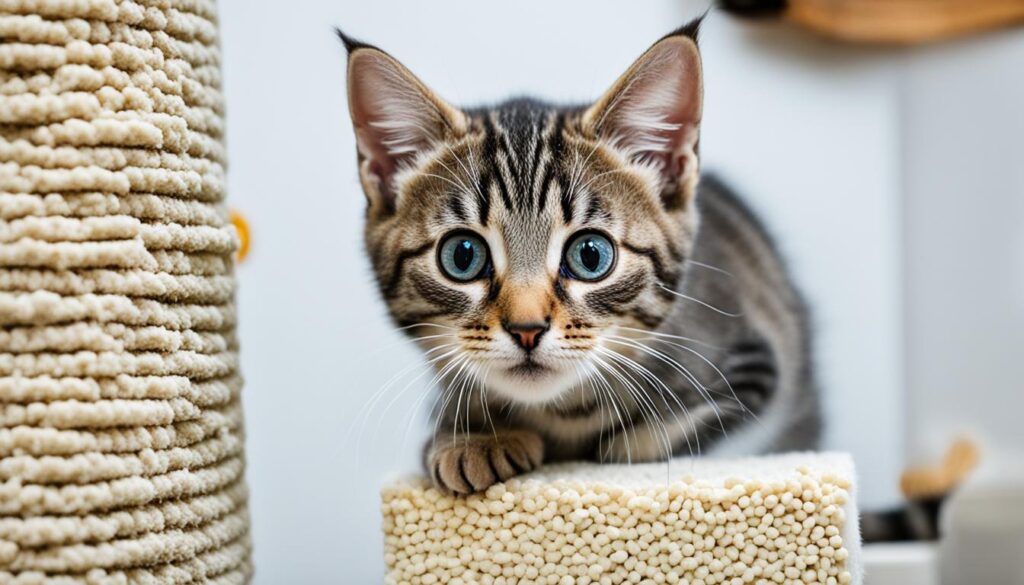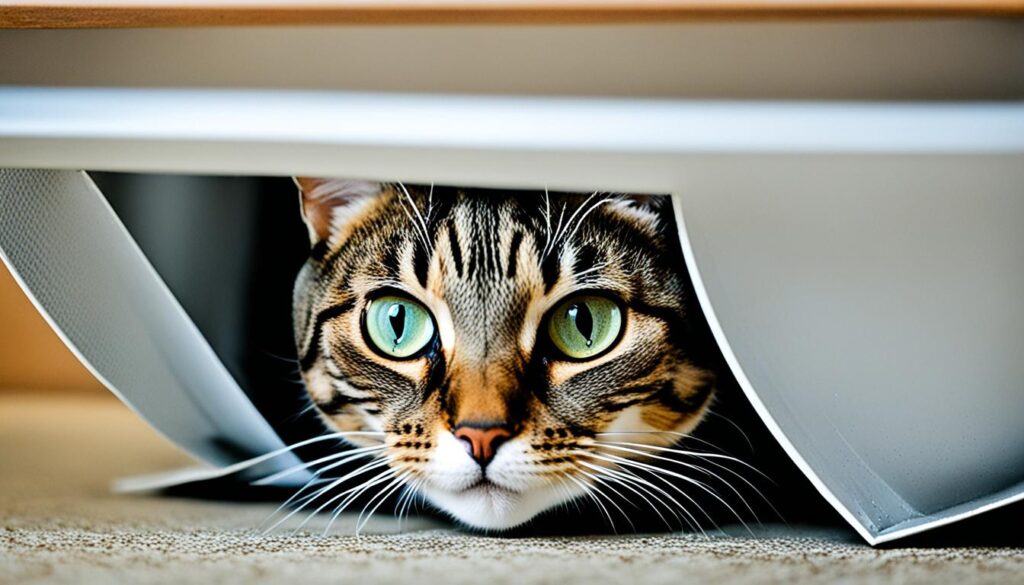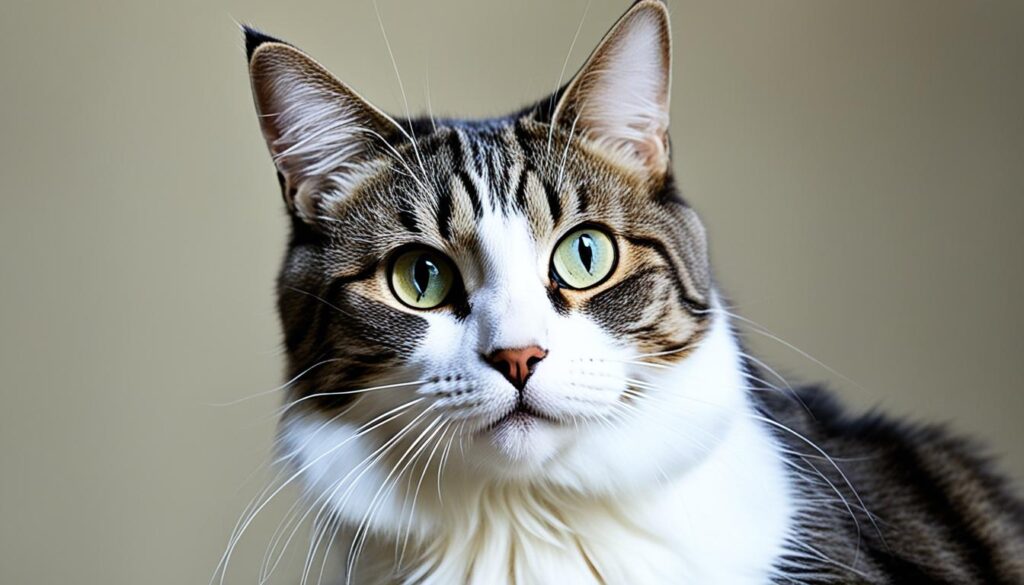Have you ever wondered what your cat is trying to tell you? From their purrs to their tail flicks, cats have a unique way of communicating their thoughts and feelings. But do we really understand their behavior and what it means? Are we missing out on crucial information that could strengthen our bond with our feline friends?
In this article, we will unravel the mysteries of cat behavior and explore the fascinating world of feline communication. Get ready to dive deep into their behaviors, understand common issues that cat owners face, and discover effective training techniques to modify unwanted behaviors. So, are you ready to decode the secrets behind your cat’s behavior?
- Key Takeaway 1
- Key Takeaway 2
- Key Takeaway 3
- Key Takeaway 4
- Key Takeaway 5
Interpreting Cat Body Language
Cats are mysterious creatures that communicate through their body language. By observing their physical cues and considering the context, you can decode what your feline friend is trying to tell you. Understanding your cat’s body language is key to building a deeper connection and providing solutions to their behavioral needs.
One significant body language clue is the position of their tail. A high, vertically lifted tail usually indicates confidence and a willingness to engage, while a low tail may suggest fear or anxiety. So, when you see your cat with a proud raised tail, know that they are ready to interact with you on their terms.
Another important posture to consider is when your cat forms a tense, ball-like shape. This could be a sign of discomfort or pain, and it’s crucial to address their well-being promptly. Conversely, a cat lying stretched out in a relaxed posture is a clear indication that they are in a state of calm.
Key Body Language Cues:
- High, vertically lifted tail: Confidence and openness to interaction
- Low tail: Fear or anxiety
- Tense, ball-like posture: Discomfort or pain
- Stretched-out posture: Relaxation
Understanding these body language cues will help you better understand your cat’s behavior and provide appropriate solutions.
By paying attention to your cat’s body language, you can decipher their emotions and address their needs effectively. This knowledge will enable you to create a harmonious environment that nurtures your cat’s natural behaviors and promotes their overall well-being.
| Body Language Cue | Meaning |
|---|---|
| High, vertically lifted tail | Confidence and openness to interaction |
| Low tail | Fear or anxiety |
| Tense, ball-like posture | Discomfort or pain |
| Stretched-out posture | Relaxation |
Common Cat Behavior Issues
Cats can be quirky and unpredictable creatures, but sometimes their behaviors can go beyond the normal feline antics. Here are some common cat behavior issues that may disrupt your daily life and the harmony in your home:
- Excessive Scratching: Is your cat turning your furniture into a scratching post? It’s essential to understand that scratching is a natural instinct for cats, but it can be frustrating when they choose your favorite couch as their personal manicure station.
- Aggression: Does your cat seem to have a case of the “cattitude”? Aggression can manifest in various ways, such as scratching, biting, or hissing. It can be directed towards humans, other pets, or even inanimate objects.
- Litter Box Problems: Is your cat using your clean laundry as a substitute for their litter box? Litter box issues can range from inappropriate urination to refusal to use the litter box altogether. It can be messy and unpleasant for both you and your cat.
- Excessive Vocalization: Is your quiet and aloof cat suddenly meowing up a storm? Excessive vocalization can be attention-seeking behavior or a sign of underlying discomfort or illness.
These behavior problems can be caused by various factors, such as stress, fear, or medical conditions. Understanding the root cause is crucial in finding appropriate solutions. It’s important to identify the underlying cause and address it with the right techniques and environmental enrichment.
To help you better understand and tackle these common cat behavior issues, let’s take a closer look at each one:
-
Excessive Scratching:
Scratching is an instinctual behavior for cats and serves several purposes, including marking territory and keeping their claws sharp. To redirect your cat’s scratching behavior, provide them with designated scratching posts or boards, and reward them when they use them. Additionally, trimming your cat’s claws regularly and using deterrents on your furniture can help protect your belongings.
-
Aggression:
Aggression in cats can range from playful swats to full-fledged attacks. It’s important to determine the trigger for their aggressive behavior and address it accordingly. Consider consulting with a professional animal behaviorist who can assess the situation and provide tailored guidance. Implementing positive reinforcement training techniques can also help to redirect their aggression towards more acceptable outlets, such as interactive play sessions with appropriate toys.
-
Litter Box Problems:
Litter box problems can result from a variety of issues, including cleanliness, litter type, or medical conditions. Ensure that your cat’s litter box is kept clean and easily accessible. Experiment with different types of litter to find the one your cat prefers. If your cat continues to have difficulties, consult with your veterinarian to rule out any underlying health problems.
-
Excessive Vocalization:
If your cat is meowing excessively, try to identify the reason behind it. They may be seeking attention, hungry, or in pain. Provide regular playtime and mental stimulation to keep your cat engaged, and ensure they have access to food, water, and a comfortable resting area. If excessive vocalization persists, consult with your veterinarian to rule out any medical issues and consider behavior modification techniques.
Remember, understanding your cat’s behavior is key to finding solutions to these common issues. Addressing the underlying cause, providing appropriate enrichment, and seeking professional help when needed will help you create a harmonious environment for both you and your feline companion.
Training and Enrichment for Better Cat Behavior
Training your cat is the key to addressing unwanted behaviors and promoting positive ones. Using positive reinforcement techniques like clicker training and rewards can effectively teach your cat new behaviors while discouraging undesirable ones. By understanding and working with your cat’s natural instincts, you can create a harmonious and well-behaved feline companion.
Positive Reinforcement Techniques
Positive reinforcement is an effective approach to cat behavior training. By rewarding desired behaviors, you can encourage your cat to repeat them while minimizing stress or fear. Clicker training is a popular technique where you use a clicker to mark the behavior you want to reinforce, followed by a treat or a reward. With consistency and patience, your cat will learn to associate the clicker sound with positive outcomes.
Here are some other tips for effective positive reinforcement:
- Use treats that your cat finds particularly delicious as rewards.
- Keep training sessions short and frequent to maintain focus and prevent boredom.
- Pair verbal cues, such as “sit” or “come,” with the desired behavior to establish a clear association.
- Be patient and avoid punishment or negative reinforcement, as it can lead to fear or aggression.
Remember, every cat is unique, and training progress may vary. Keep the training sessions fun, positive, and rewarding for your cat to achieve the best results.
Environmental Enrichment
Providing a stimulating and enriched environment is vital for your cat’s overall well-being and behavior. Cats are natural hunters and explorers, so offering activities that mimic these behaviors can help fulfill their instincts and alleviate boredom.
Consider incorporating the following enrichment activities into your cat’s daily routine:
- Puzzle Feeders: These toys require your cat to work for their food, stimulating their problem-solving skills and providing mental stimulation.
- Interactive Toys: Toys that move or dispense treats can engage your cat’s prey drive and provide entertainment.
- Vertical Spaces: Cats enjoy climbing and perching. Providing vertical spaces like cat trees or shelves allows them to fulfill their natural desire to be up high.

A visually engaging and cat-relevant image adds aesthetic appeal and captures the attention of readers. The provided image visually represents the topic of cat behavior training, emphasizing the importance of training and enrichment in shaping a well-behaved cat.
Creating a cat-friendly environment with training and enrichment activities is crucial for promoting positive behaviors and preventing behavioral issues. By positively reinforcing desired behaviors and providing stimulating experiences, you can help your cat lead a happy, fulfilling, and well-balanced life.
Understanding Cat Health and Behavior
Cats are mysterious creatures with unique behaviors and traits. Sometimes, changes in their behavior can indicate underlying health issues. It’s essential for cat owners to closely monitor their feline companions and be aware of any signs of distress or discomfort that may manifest in their behavior.
Excessive grooming, changes in appetite or litter box habits, and aggression are some common warning signs that something might be affecting your cat’s well-being. If you notice any significant changes in your cat’s behavior, it’s crucial to consult with a veterinarian to rule out any potential medical conditions that might be contributing to their behavioral changes.
A veterinarian will be able to conduct a thorough examination, run necessary tests, and provide a diagnosis and treatment plan if needed. They have the expertise to determine whether the behavior is a result of an underlying health issue or strictly behavioral in nature.
Remember, cats are masters at hiding their discomfort or pain, so it’s important to be vigilant and observant of any changes in their behavior.
By addressing your cat’s health concerns promptly, you can help ensure their overall well-being and potentially prevent any further behavioral issues that may arise as a result.

| Medical Condition | Behavioral Manifestations |
|---|---|
| Urinary Tract Infection | Urinating outside the litter box, increased frequency of urination, vocalization during urination |
| Arthritis | Limited mobility, difficulty jumping, decreased activity level |
| Hyperthyroidism | Increased appetite, weight loss, restlessness, excessive grooming |
| Dental Disease | Decreased appetite, drooling, pawing at the mouth |
These are just a few examples of medical conditions that can impact a cat’s behavior. It’s important to consult with a veterinarian for an accurate diagnosis and appropriate treatment for your feline friend.
Creating a Cat-Friendly Environment
Creating a cat-friendly environment is essential for addressing cat behavior problems, solving cat behavior issues, and finding effective cat behavior solutions. By providing your feline companion with the right resources and atmosphere, you can promote positive behaviors and reduce stress in your cat.
Cats need access to essential resources such as food, water, litter box, scratching posts, and resting areas.
Ensuring that these resources are easily accessible and strategically placed throughout your home can help prevent behavioral issues and create a harmonious living space for both you and your cat.
The Importance of Resource Accessibility
When it comes to food and water, make sure to provide multiple feeding and watering stations in different areas of your home. This prevents competition and allows your cat to have easy access to refreshments whenever they need them.
For the litter box, have one per cat plus an extra one. Place the litter boxes in quiet and easily accessible areas to avoid any litter box issues or accidents.
Don’t forget to provide your feline friend with an appropriate number of scratching posts throughout your home. Cats need to scratch to exercise and maintain their claws, so having enough scratching options will help prevent destructive scratching on furniture.
Creating Restful Spaces
Cats are known for their love of napping, so it’s crucial to provide them with comfortable resting areas. Set up cozy cat beds, cat towers, or window perches in quiet corners of your home where your cat can relax and observe their surroundings.
Adding a soft blanket or a familiar item, such as a sweater with your scent, can make these spaces even more appealing to your furry friend.
“A nurturing environment with easily accessible resources and comfortable resting areas plays a significant role in promoting positive cat behaviors and reducing stress in cats.”
Promoting Environmental Enrichment
Environmental enrichment is essential for keeping your cat mentally stimulated and engaged. Provide interactive toys, puzzle feeders, and catnip-filled toys to keep your cat entertained and mentally challenged. Additionally, consider creating vertical spaces such as shelves or cat trees that allow your cat to climb and explore their environment.
Remember, a bored cat is more likely to develop unwanted behaviors, so making sure your cat has plenty of opportunities for play and exploration is crucial for their overall well-being.
By creating a cat-friendly environment that addresses your cat’s natural instincts and needs, you can help prevent cat behavior problems, resolve cat behavior issues, and ultimately find effective cat behavior solutions. With the right resources, resting areas, and environmental enrichment, you’ll create a peaceful and harmonious living space for both you and your beloved feline friend.
Socialization and Bonding with Your Cat
Building a strong bond with your cat is the key to their overall well-being and behavior. Cats, just like humans, thrive on social connections and interactions. It is vital to engage in socialization from a young age to help your feline companion feel comfortable in various situations.
Spending quality time with your cat is essential for fostering a strong bond. Create opportunities for interactive play sessions, such as using feather wands or laser pointers, to stimulate their natural hunting instincts. This not only keeps them physically active but also strengthens the bond between you and your cat.
Providing affectionate interactions is another way to enhance your bond. Cats enjoy gentle petting and cuddling, and these displays of affection can deepen your connection. Each cat has its preferences, so pay attention to their body language and respond accordingly. Some cats may prefer short bursts of attention, while others may enjoy extended cuddle sessions.
Remember, the key to successful socialization and bonding is to respect your cat’s boundaries. If your cat shows signs of discomfort or stress, give them space and allow them to approach you on their terms. Building trust takes time, but with patience and consistent positive experiences, your bond will grow stronger.
“A cat’s love and trust are earned, just like any valuable relationship. Be patient, understanding, and always respect their comfort zone. The bond you build will reward you with a lifetime of love and companionship.” – [Real Name]
Seeking Professional Help for Cat Behavior
If you’re dealing with stubborn cat behavior problems or struggling to understand your feline friend’s quirks, don’t fret. Sometimes, expert guidance is necessary to navigate through these issues and ensure a happy and harmonious relationship. That’s where certified cat behaviorists or animal behavior consultants come in.
These professionals have the knowledge and expertise to provide personalized advice and tailored behavior modification plans for your cat’s specific needs. Whether it’s addressing excessive scratching, aggression, or litter box problems, they can guide you through the process with effective solutions.
Cat behaviorists use their in-depth understanding of feline behavior to decode the root causes behind your cat’s troublesome habits. By identifying the underlying factors, they can help you implement strategies that will yield long-lasting results.
“Certified cat behaviorists are like cat whisperers. They have an uncanny ability to decipher the complexities of feline behavior and find solutions that work.” – Samantha Adams, Cat Enthusiast
One major advantage of seeking professional help is the individualized attention your cat will receive. Behaviorists take the time to assess your cat’s environment, daily routine, and interactions to create a comprehensive plan that suits their unique personality. This tailored approach increases the chances of success and ensures that your cat’s well-being remains a top priority.
Benefits of Professional Assistance:
- Expert guidance from certified cat behaviorists or animal behavior consultants
- Personalized advice and behavior modification plans
- Identification of root causes behind behavior problems
- Individualized attention and tailored approach
- Increased chances of long-lasting behavior improvement
Remember, seeking professional help is not a sign of failure but rather a proactive step towards understanding and resolving cat behavior problems. With the right guidance, you can address complex issues effectively and create a happier, more harmonious home for both you and your feline companion.
Conclusion
Understanding your cat’s behavior is the key to a harmonious relationship with your feline companion. By decoding their body language, addressing common behavior issues, implementing effective training techniques, and creating a cat-friendly environment, you can ensure a positive and fulfilling experience with your cat.
Interpreting your cat’s body language enables you to understand their emotions and intentions, allowing you to respond appropriately. By knowing the difference between a confident tail wag and a fearful one, or a relaxed posture and a tense one, you can better understand what your cat is trying to communicate.
Common cat behavior issues like excessive scratching, aggression, and litter box problems can be tackled through behavior modification techniques and environmental enrichment. Positive reinforcement training, coupled with providing a stimulating and enriching environment, can help redirect unwanted behaviors and fulfill your cat’s natural instincts.
Furthermore, it’s crucial to prioritize your cat’s health and seek professional help when needed. Changes in behavior can sometimes be indicators of underlying health issues, so monitoring your cat closely and consulting with a veterinarian is essential. Additionally, certified cat behaviorists or animal behavior consultants can provide personalized guidance and behavior modification plans to address complex issues effectively.
Remember, building a strong bond with your cat through socialization, interactive play sessions, and affectionate interactions is fundamental to their well-being and behavior. By dedicating quality time and nurturing the relationship, you can further enhance your cat’s overall behavior and temperament.

